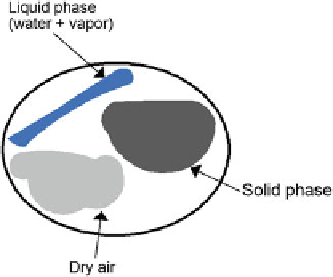Civil Engineering Reference
In-Depth Information
geometric fibre model was used in studying 2D transient heat and moisture transport
behaviour through fabric. The mass and energy conservation as well as capillary
phenomenon was considered in the model (Luo and Xu
2006
).
Zhao et al. (
2009
) presented a numerical model of combined radiation and
conduction heat transfer to predict the effective thermal conductivity of fibrous
insulation at various temperatures and pressures. Effective thermal conductivities
of the fibrous insulation were measured over a wide range of temperature and
pressure. Using different mathematical models of heat flow, Roy et al. (
2006
)
studied the porosity dependence of heat flux through glass fibre insulation. Ka-
ramanos et al. (
2008
) developed a model for evaluating the performance of stone
wool under varying temperature and humidity conditions. Bao and Yee (
2002
)
studied moisture absorption and hygrothermal ageing in a woven and woven/uni-
weave composites. The short-term absorption curves of the uni-weave/woven/uni-
weave and woven/uni-weave/woven composites were described by Fickian dif-
fusion and the dual-diffusivity model, respectively.
In the experimental literature, (Fan et al.
2003
) presented an experimental result
on the temperature and water content distribution within the porous fibrous bat-
tings sandwiched by an inner and outer layer of thin covering fabrics using a novel
sweating, guarded hot plate. It was found that most of the changes in temperature
distribution took place within 1/2 h of the tests and moisture absorption by the
hygroscopic fibres affected the temperature distribution. Higher water content, a
combined result of moisture absorption, condensation and liquid water movement,
was found at the outer regions than that at the inner regions of the battings.
For more general heat and moisture transfer model equations for hygroscopic
fabrics or porous materials, please refer to (Lu
2002a
;
b
; Osanyintola
2006
; Wu et al.
2007
). Very often, the obtained model equations are complex which do not permit
simple analytical solutions. Therefore, different approaches like finite element
method, finite difference method, and finite volume method are used to solve the
equations. For more literature, refer to Pan and Gibson (
2006
) and Oduor (
1999
).
In this chapter, the macroscopic model configuration is presented in Fig.
17
.
The moisture transport is divided into liquid and vapour flow. The liquid transport
is based on Darcy and capillary flow equations. The vapour flow is driven by
Fig. 17 Macroscopic model
configuration

